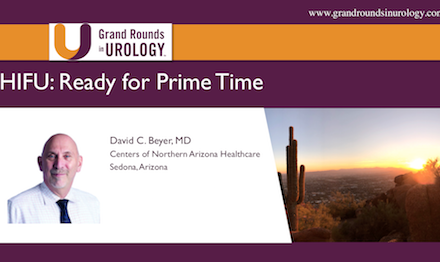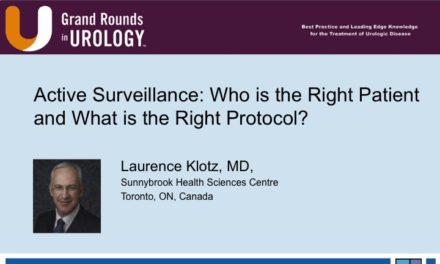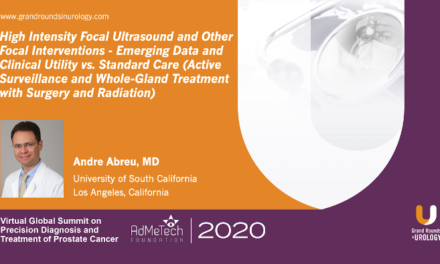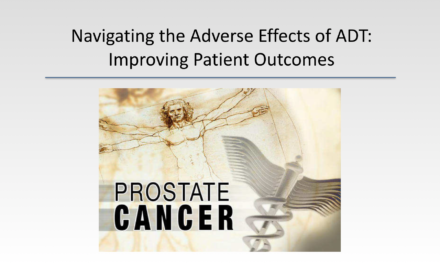Dr. Neal D. Shore spoke at the 25th International Prostate Cancer Update on Friday, January 23, 2015 on “Current and Future Opportunities with Immunotherapy.”
Keywords: Immunotherapy, prostate cancer, antigenic, Provenge, PSA, Prostvac
How to cite: Shore, Neil D. “Current and Future Opportunities with Immunotherapy ” Grand Rounds in Urology. April 30, 2015. Accessed Dec 2024. https://dev.grandroundsinurology.com/prostate-cancer-neal-d-shore-opportunities-with-immunotherapy/.
Transcript
Current and Future Opportunities with Immunotherapy
Here are the objectives of my talk. What’s the rationale for immunotherapy? Why even think about it as opposed to chemotherapy, or oral oncolytics, and what are the indications and where are we in terms of state of the art approvals and where are we in the future for a combinatorial strategies?
This was the front cover of Science magazine in 2013. I can tell you if you went to ASCO last year and I’m sure this year, this is the bond, this is the buzz. Immunotherapy is it. This is really a lot of sexy stuff going on here. I think for us as urologists, or most of us in the room, the time is now to understand that if you don’t follow up with this, you won’t be able to really understand fully all the ramifications for your treatment paradigms in CRPC, and soon to be in bladder cancer as well.
The T cell which is really central to everything in immuno-oncology, I mean this is the absolute warrior that attacks cancer cells, infectious protein, viral etiologies as well, and you think of these two things that you probably heard this analogy before, the foot on the gas, the foot off the brakes, these checkpoints. We have abilities to activate the T cell, we have abilities to think about spread, antigenic spread in a good way. Antigenic spread is where we may attack one particular antigen in advanced cancer, and have the immune system develop opportunity to fight other downstream antigens as well.
The antigenic drift that we see in the flu is a sort of a negative phenomenon where our vaccine therapies are not helpful but an antigenic drift or an antigenic cascade in immunotherapy can actually be quite beneficial and I’ll talk more about that.
The T cell when it’s activated has actually fairly very limited toxicity. We have the checkpoint modulators and we’ll talk more about that, especially as it relates to potentiating the T cell. I thought today as I was skiing how to make that analogy and I’m thinking to myself, the skis are the potentiated T cell just going straight down the hill, point your tips down the hill and you’ll just go perfectly well. Well not really because you’ll eventually lose control and you’ll implode. Just as well as an activated T cell, if there wasn’t some sort of a checkpoint, you would emulate into a ball of pus. There is sort of the taking the checkpoint off the ski might be taking your edges off and/or your ability to turn the skis one way or the other. These analogies are the checkpoint that we see that I’ll talk about as well as the ability to turn your skis thoughtfully, maybe these are something analogous to T regulatory suppressor cells.
One of the things that’s really important, I appreciate going back to our basic immunology is the prime-boost effect. We heard last night at the posters the heterologous prime boost that we see in using viral envelopes to deliver certain types of immunotherapy in the PROSTVAC and I’ll get to that in a second. But what you really see here is an opportunity to do several things, expansion, which is to amplify the existing T cell population. Amplification is one of the T cell parameters we look at. We look at CD54 amplification and activation as well as metrics for understanding is the immunotherapy actually working. Then I mentioned antigenic cascade so if we’re targeting PSA or PAP, how could it get to MIC-1 or PSMA or other antigens that develop or lead to further progression.
This is really truly some of the unique aspects of the immunotherapeutic regimen. Additionally there’s memory. When we give oral oncolytics just like if we’re giving an antibiotic or a cytotoxic chemotherapy, it only works for as long as we give it. Immunotherapeutic strategies have the ability to break tolerance, turn the immune system on, and have it linger or once we’ve stop giving that therapy. It has a very profound exciting potential.
Looking at conventional therapies, as I just said they target the microenvironment, they may target one particular receptor or tubulin or an AR, but the immune system doesn’t come on right away. There is a delayed phenomenon and additionally there’s ability to have memory. Now the memory phenomenon we’ll further discuss is probably best suited when patients are less immunosuppressed and it gives an opportunity for further time for activation of this immuno effect. Then later on downstream ability to recall memory or centrally reposited T cells.
I won’t go into too much, this was a seminal trial. This was the Provenge IMPACT 9902B. Phil Kantoff is the first author of this publication, many of us here were part of it, essentially demonstrating the first, any immunotherapeutic, any metastatic solid tumor showing a survival benefit. The cycle of Q2 weeks times 3 is a pheresis that lasts about three hours. It’s segregating out the antigenic presenting cell population, the APCs, autologous specific to the individual patient. Combining them with the fusion protein, in this case PA2024, focusing on prostatic acid phosphatase. Then ultimately reinfusing it into the patient 48 hours later over about a one hour period peripheral IV. Safety, tolerability, extremely good. Probably the more challenge here is just the pheresis, getting peripheral access, and for some requiring a central venous catheter.
Here’s the KM, the 4.1 months. Article published, approved and available since 2010 in the United States and now being given, Axel Heidenreich gave the first dose or first course in Europe this year.
Giving an immunotherapeutic, does the early bird catch the worm? Is it better to give it early and I would argue the answer is yes.
And thanks to Paul Schelhammer’s article, and David is actually one of the authors on it. He’s presented this I believe at AUA as well as in ASCO, really what you see here. If you basically focus on the difference column, what we did, this is quartile data, and we looked at the patients who had PSAs less than 22 at baseline, 22 to 50, 50 to 134, greater than 134 as a potential surrogate for volume of disease and with higher tumor burden, more immunosuppression, look at the difference, again retrospective post hoc analysis, but look at the difference in survival between the patients who received Provenge versus those who did not. Thirteen months survival difference versus 2.8 month at the top quartile. I think that goes to a lot of other great work that’s been done demonstrating that immunotherapeutics work best in less tumor burden and more intact immune system, greater period of time to respond to the therapy.
We don’t see PSA regression, we don’t see regression of disease, but what we do see, and this is a nice paper and Chuck Drake has published on this as has James Gulley and others who are renowned immunobiologists demonstrating that if you give the therapy early, what you’re seeing is stabilization of disease, you’re slowing down the growth rate of the tumor. And as we know in all CRPC therapies, we don’t cure, we stabilize disease, and we try to maintain quality of life.
The antigenic spread phenomenon as you can here, it’s a little bit of a busy slide, but if I look over here. You go over here if you’re targeting one antigen whether it’s PAP, PSA, PSMA, MUC-1, and basically your T cell comes, finds that target. You get an apoptotic effect, scavenger earlier forms of white cells known as antigen presenting cells. They come in, pick up additional tumor antigens and then become activated and further announce that or present that to a naive T cell. So this concept of a cascade or antigenic build is really unique and particularly powerful for immunotherapeutics.
This is a little bit of a busy slide but it was presented by Chuck Drake demonstrating in patients at least who received Provenge that when they had this antigenic spread as demonstrated by… showing a build from a PAP but other secondary antigens as well, patients actually had improvement in survival.
In summary regarding the sip-T you see antigenic spread, it’s been demonstrated, it’s not scalable in a commercial way. We don’t have biological markers that we can use in the clinic in a real time way but what we are getting is additional understanding of this antigen antibody manipulation and the concept of spread as well as the phenomenon or memory.
In terms of the where we are with the Provenge which has been approved since 2010, there have been multiple studies that we’ve looked at now and participated in, and many of these are being ongoing follow-up in terms of their efficacy and tolerability. One here is the P10-2 and this was an interesting study that we’re doing. It recalls Marc Garnick’s comments today and for patients who have PSA relapse and patients given androgen deprivation therapy. There was initially we see this thymic regression and involution, and now you see some hypertrophy when you give ADT and whether or not giving ADT three months before Provenge or right after a course of Provenge will have any evidence on PSA kinetics. We have an abstract coming up in ASCO on that.
Looking at the P12-2, the stand and the stamp below that is combining and sequencing enzalutamide and abiraterone and so what we’ve seen in a nutshell in both of those is that the parameters to make sipuleucel-T have not been affected. What are the immune parameters? CD54, absolute count, activation as well as a T cell activation.
We’re seeing right now at least in these small phase 2 studies that combinatorial strategies are potential. We need longer term data to look at efficacy responses. The PROCEED which is a registry that was started with almost 2,000 patients. I think Raoul Concepcion, Stephen Freedland are in the room and others have been participating in this. We’re also following these patients really carefully looking at what happens in both African-American men in underserved populations, seeing interesting responses there but also whether or not and how they’re responding to abi and enza.
Let me talk about PROSTVAC which I’ve had the good fortune to work with now in a big phase 3 trial which we’ve just completed accrual and it’s very exciting. This is not using a pheresis methodology but rather using viral vectors, two different ones, Vaccinia and Fowlpox, which is essentially using it as a carrier to allow for a slightly altered version of a PSA transgene, and these three costimulatory molecules. You’ll see them at the bottom here, LFA-3 which is also CD58, ICAM, intercellular adhesion molecule CD54, and B7.1, CD stands for cluster of differentiation.
What these do and what you see here and published again by the authors on the far right demonstrates again this really nice phenomenon of antigenic spread. Even though we’re gearing this subcutaneous based viral vector phenomenon with a plasmid to target PSA, load up into the APCs, which go to the sentinel nodes, which go to various lymph nodes and transport throughout the whole reticular endothelial system, we’re seeing uptake in relationship with other markers as well.
The excitement of this came at a phase 2 study which showed literally an 8.6 month differential in survival small numbers, phase 2, and this has now led to the phase 3. Again, it’s exciting to recognize we just completed accrual for this.
This was a global trial, a three-arm trial looking at PROSTVAC with GM-CSF, PROSTVAC alone, and a pure placebo. There’s no crossover, primary endpoint is overall survival. This is an off the shelf administration, this is given subcutaneously. It takes place over approximately a five month period. So potentially much more use friendly in the clinic.
I’ve just put this out here. I wrote this article this year. If you want to pick this u and just read this, it will go into a lot greater depth about the differences between these two immunotherapies, and just immunotherapy in general.
What’s the rationale for combining some of these really interesting T cell activated therapies such as PROSTVAC as well as sipuleucel-T, and then the checkpoint inhibitors. A lot of great work going on right now with checkpoint inhibitors and other solid tumors whether it’s lung, kidney, colon, and bladder, but how can we further advance it.
Now if you just look, this is a busy slide, but if you look at the PD-1 focus on, there’s so many different checkpoints that we could be looking at. PD-1 program cell death 1 and PG ligand 1 are two of the hottest. There’s multiple companies that are out there investigating, interrogating, let me just tell you about one trial that was done.
It’s interesting, it’s a failed trial and this was looking at ipilimumab, Yervoy, approved for melanoma, and we did in this particular trial is post-docetaxel progression, they got one dose of radiation that concept of the abscopal effect, releasing antigen, maybe having more immunological phenomenon elsewhere, randomized to either receiving ipi or placebo. Long story short, and Jack Trait [phonetic] presented this at ASCO GU last year, didn’t hit statistical significance in the totally of the trial. But if you look at the top line, the blue and the red at the bottom, the patients who were ipi with visceral metastases versus no visceral metastases, look at the delta and the median overall survival.
Some of this has to do with how we stratify our inclusion and exclusion criteria. We’re learning a lot more about the phenotype of these diseases, but again, this is a very compelling and interesting trial.
And here are the conclusions. I’ll let you read them for purposes of time. If we looked at it post hoc and segregated out certain populations, there clearly seems to be benefit.
Busy slide. I like this because it tells me all about the different ways we’re combining the different buckets, whether it’s removing immunosuppression, or immunogenic cancer cell death or enhanced antigen presentation. There are these ongoing things that we have within us, these checkpoints, regulatory cell suppression, various cytokines, IL-6, T regulatory cells as I mentioned, TGF beta, and we’re getting a much better understanding on how we can block and/or eliminate some of these regulatory suppressor focuses.
Now there are so many more therapies in the pipeline, here’s just a few of them. We’re starting to do some interesting trials right now. The far end is sotio, this is also a D cell vaccine, dendritic cell vaccine in combination with chemotherapy. Low dose chemotherapy, historically we think of chemotherapy as a terrible myelosuppressive and immunosuppressive. When in low dose it can have potentially a positive effect by reducing T regulatory cell burdens. Looking at some other immunotherapeutics with electroporation, in muscle further releasing antigen as well as others, some interesting radiation studies and we’re starting to look at immunotherapeutics in the setting of androgen sensitive, not moving forward with androgen deprivation therapy. There are a couple of different companies that are moving forward with that and so you avoid all of the toxicities of ADT which Lenny spoke of.
Here’s a slide, William Oh presented this, but we’ve made great progress in four years. There’s no doubt in my mind that immunotherapy is here to stay. We have Provenge, PROSTVAC, hopefully will parallel or really come close to its phase 2 trial, survival benefit, a different form to administer, as well as other immunotherapies that have been put into phase 2 and phase 3 trials now.
The combination use and the potential for it is what we’re all striving for is that we want to come up with a cure, and if not a cure, keep patients alive as long as possible so that they die of old age or euphemism for cardiovascular event, but not die of their malignancy. So one can see all these different potential therapies, whether it’s oral tyrosine kinase to lower tumor regulatory burden, low doses of cytotoxics combining with existing oral oncolytics, radiopharmaceuticals potentially, and obviously checkpoint inhibitors and T cell activators.
Another paper just that I wrote and if you have time and you wanted to pick something up to get an understanding of this, and I only put this up there to encourage you to learn more about the field so that you’re up to speed on all the CRPC opportunities.
I’ll stop with this. This is a brief conclusion on immunotherapies.
References
Aragon-Ching JB, Williams KM, Gulley JL. et al. Impact of androgen-deprivation therapy on the immune system: implications for combination therapy of prostate cancer. Front Biosci. 2007 Sep 1;12:4957-71.
http://www.ncbi.nlm.nih.gov/pubmed/20651745
Drake CG. Prostate cancer as a model for tumour immunotherapy. Nat Rev Immunol. 2010 Aug;10(8):580-93.
http://www.ncbi.nlm.nih.gov/pubmed/20651745
Drake CG, Doody AD, Mihalyo MA, et al. Androgen ablation mitigates tolerance to a prostate/prostate cancer-restricted antigen. Cancer Cell. 2005 Mar;7(3):239-49.
http://www.ncbi.nlm.nih.gov/pubmed/15766662
Gulley JL, Drake CG. Immunotherapy for prostate cancer: recent advances, lessons learned, and areas for further research. Clin Cancer Res. 2011 Jun 15;17(12):3884-91.
http://www.ncbi.nlm.nih.gov/pubmed/21680544
Kantoff PW, Higano CS, Shore ND, et al. Sipuleucel-T immunotherapy for castration-resistant prostate cancer. N Engl J Med. 2010 Jul 29;363(5):411-22.
http://www.ncbi.nlm.nih.gov/pubmed/20818862
Kirkwood JM, Butterfield LH, Tarhini AA, et al. Immunotherapy of cancer in 2012. CA Cancer J Clin. 2012 Sep-Oct;62(5):309-35.
http://www.ncbi.nlm.nih.gov/pubmed/22576456
Mercader M, Bodner BK, Moser MT, et al. T cell infiltration of the prostate induced by androgen withdrawal in patients with prostate cancer. Proc Natl Acad Sci U S A. 2001 Dec 4;98(25):14565-70.
http://www.ncbi.nlm.nih.gov/pubmed/11734652
Nesslinger NJ, Ng A, Tsang KY, et al. A viral vaccine encoding prostate-specific antigen induces antigen spreading to a common set of self-proteins in prostate cancer patients. Clin Cancer Res. 2010 Aug 1;16(15):4046-56.
http://www.ncbi.nlm.nih.gov/pubmed/20562209
Schellhammer PF, Chodak G, Whitmore JB, et al. Lower baseline prostate-specific antigen is associated with a greater overall survival benefit from sipuleucel-T in the Immunotherapy for Prostate Adenocarcinoma Treatment (IMPACT) trial. Urology. 2013 Jun;81(6):1297-302.
http://www.ncbi.nlm.nih.gov/pubmed/23582482
Schlom J. Therapeutic cancer vaccines: current status and moving forward. J Natl Cancer Inst. 2012 Apr 18;104(8):599-613.
http://www.ncbi.nlm.nih.gov/pubmed/22395641
Slamon DJ, Leyland-Jones B, Shak S, et al. Use of chemotherapy plus a monoclonal antibody against HER2 for metastatic breast cancer that overexpresses HER2. N Engl J Med. 2001 Mar 15;344(11):783-92.
http://www.ncbi.nlm.nih.gov/pubmed/11248153
Vermorken JB, Mesia R, Rivera F, et al. Platinum-based chemotherapy plus cetuximab in head and neck cancer. N Engl J Med. 2008 Sep 11;359(11):1116-27.
http://www.ncbi.nlm.nih.gov/pubmed/18784101
ABOUT THE AUTHOR
Neal D. Shore, MD, FACS, is the Medical Director for the Carolina Urologic Research Center. He practices with Atlantic Urology Clinics in Myrtle Beach, South Carolina.
Dr. Shore has conducted more than 350 clinical trials, focusing mainly on genitourinary oncology, and serves on the executive boards of the Society of Urologic Oncology and the Bladder Cancer Advocacy Network. He is Past President of the Large Urology Group Practice Association. He is a founder for both CUSP Clinical Trials Consortium and DASHKO, a national urology practice data registry. He serves as the National Urology Research Director for 21st Century Oncology. He has served on the AUA Male Health Committee and the AUA Data Committee, the SITC Task Force for Prostate Cancer, the Bladder Cancer Advocacy Think Tank, and the Editorial Boards of Review in Urology, Urology Times, Chemotherapy Advisor, OncLive, PLOS ONE, Urology Practice, and World Journal of Urology. He serves as Editor of Everyday Urology-Oncology. Dr. Shore has written more than 200 peer-reviewed publications and numerous book chapters. He performs peer review for Lancet Oncology, New England Journal of Medicine, European Urology, the Journal of Urology, Urology, BJUI, PCPD, and numerous other high-impact scientific journals.
A graduate of Duke University and Duke University Medical School, Dr. Shore completed a 6-month clinical research fellowship in Pretoria, South Africa, and then completed his General Surgery/Urology training at New York Hospital Cornell Medical Center and at Memorial Sloan-Kettering Cancer Center in New York City. He is a Fellow of the American College of Surgeons.





